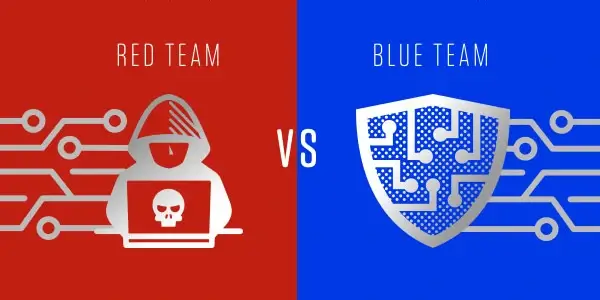
As the modern world moves almost entirely online, so do the issues we used only to face in the physical world. In years gone by, security may have taken the form of a CCTV camera or a person hired to ensure customers don't steal from your premises. As you can probably tell, neither of these solutions works regarding cybersecurity and keeping a business safe online.
Just as those who would wish your business harm adapt to an ever-changing web-based infrastructure, organizations must always use online methods to keep one step ahead of them. Banking, medical centers, and contact center optimization rely heavily on up-to-date, workable cybersecurity solutions to function correctly.
One commonly used tactic for monitoring cybersecurity is known as red-teaming and blue-teaming. Inspired by military warfare gaming, it's a practice that deals with ethical hacking and helps shore up a company's defenses. This guide will explore precisely what red-teaming and blue-teaming are and examine some exercises you can run with them.
What is Red-Teaming?
Before we move on to how you can use this tactic to your advantage, let's first make sure that all the relevant terminology is understood. There's no point exploring the benefits of a system or sharing tips on getting started if nobody knows what we're talking about.

Dating back to 19th Century Germany, red-teaming is a tactic developed by the military of that era. Using a board game to simulate battles that used tokens and representations of locations and battlegrounds, the purpose was to prepare for the unpreparable, the unpredictable, and the previously unforeseen.
It's a proactive way of allowing for chance and out-of-control circumstances in a manner that shouldn't catch you quite as off guard as if you did without it altogether. And, in modern terms, the essence of Red-Teaming remains the same.
It isn't a bulletproof method of protecting against absolutely everything that some hacker can throw at you. If your PayPal or Shopify problems persist after redteaming, there's probably an underlying issue at hand. Instead, it's a way of measuring an organization's online presence and ability to deal with cyberattacks to address areas of weakness.
Red Teaming involves adopting an adversarial approach and providing feedback from that perspective.
What Is Blue-Teaming?

With red teaming, you're getting an all-out assault on the security of your network and online presence. Having something to counteract when this happens can be a good idea. Hence, the blue team. Organizations generally appoint these to maintain a network's internal defenses against outside attacks and oversee the security issues of integrating new systems.
So, in short, red teams do the attacking, and blue teams do the defending. But blue teams exist because of the not-always-on nature of red teaming. As a costly endeavor - in some cases, up to $250 an hour - red-teaming is generally reserved for industries that generate energy and nuclear power, as when their output is tampered with, it can have wide-ranging consequences.
Whereas, with blue-teaming, you're actively hiring people to do the job regularly, something that needs to be facilitated, given the around-the-clock nature of hacking in the present time. They are an important cog inside the organization but are inside nonetheless and, therefore, are treated as any other function of the wider business.
Penetration Testing
It is now time in our red-team-blue-team journey to discuss penetration testing. As the name suggests, it's a tactic used to conduct a test to penetrate existing cyber defenses. How, then, is this different from red-teaming? Well, let's clear this up.

Penetration testing, also known as pentesting, is a simulated cyberattack that tests security. It is organized and confined by a pre-agreed scope and the 'terms of engagement.' In other words, it's a focused, specific tactic used to assess the functionality of a given defense that exists in a single area. It does not cover an entire organization.
Alternatively, red-teaming is more of your Aristotle Onassis variety of attacks. The rules are there are no rules. It's full-scale, everything-and-the-kitchen-sink-style in its scope, forcefulness, and thoroughness. It isn't scheduled; there are no terms of engagement. It replicates a real cyberattack, except the organization has asked for it.
Once a red team member is 'in' the system, they'll generally attempt to steal details of some kind. The ease with which this is done then decides the results and findings of the red team.
Example Exercises
You can do many exercises, either with a red or a blue team, to help build a decent operational security network around an organization's data. As with the rest of this piece, we'll look at them in isolation here and share some examples of exercises that can be run, whether you're red-teaming or blue-teaming.

For the red team, it's important to remember that they start by pooling information about the 'target.' This will often include which OS (operating system) is used, what networking the organization uses, including internet and voice-over IP routers, and so on. Maps are then drawn up, allowing them to plan the attack more thoroughly and identify whose details they want to steal if that is the aim.
Some exercises for red teaming include:
- Intercepting communications: by gathering data from emails, calls, texts, messages, and other communication methods, red teams can extract potentially crucial information.
- Social engineering: red teams aren't only about getting into a network through digital means. Leaning on personnel, hoping that they divulge crucial information, can highlight any security risks in the workforce.
- Cloning details: this is similar to bank account fraud, and red teams can use the same tactic on company cards when they acquire them.
- Phishing: we've all seen warnings about the dangers of interacting with a harmful phishing email, so naturally, red teams also try to use this tactic.
- Penetration testing: the standard way for red teams trying to hack into a network is through the network itself. It is very much the first port of call, so the above tactics may not be necessary.
Alternatively, the blue team typically consists of consultants or in-house security experts. Their roles are generally to advise teams on how to respond to cyberattacks, and their starting point is very much the other side of the red team's coin. The first task they'll undertake involves data gathering and identifying which systems need protection, something that's got a lot more complex with the move to remote working. When blue teaming nowadays, a remote work operating system can help pool resources to great effect. This will lead to risk assessments of potential shortcomings and threats, leading to security measures being drawn up and implemented.
Some exercises for blue teaming include:
- IDS & IPS: IDS (intrusion detection systems) and IPS (intrusion prevention systems) are software deployed as an investigator and a preventative measure, respectively.
- DNS: audits run using DNS (domain name system) ensure that the protocol that the internet relies on to run effectively is intact.
- Firewalls: installing firewalls and antivirus software is something that most personal computer users do, so not having this set up as a business is nonsensical.
- Digital Analysis: this helps to build a picture of the day-to-day reality of network activity so that patterns and, therefore, anomalies are more easily identified.
- Endpoint Software: this is more about remote devices - a reality of work now that hybrid working has become so widely appreciated - such as company laptops and cell phones. Installing this software ensures that these devices aren't an external way for hackers to enter the internal network.

Conclusion
In this article, we've looked at what red teaming and blue teaming are. We've illustrated the role of both in finding and rectifying cybersecurity weaknesses and have shared some exercises that both can use to achieve their given aim.
The internet connects us all, not only on a personal level but also on a business one. The frameworks that keep individuals and companies safe online have never been more critical and, as such, have never been more complex.
Running drills with red and blue teams is something that companies have utilized in the past. It shores up any chinks in their armor and ensures that the business's network is protected against the most up-to-date methods of attack that actual hackers have in their arsenal.
It's an element of online business that you cannot afford to be complacent about, especially if your framework stores customer data of any kind. Using the techniques of red and blue teams can help achieve the utmost safety for you and your business, so get started today.


 Copyright 2000-2025, WebSitePulse. All rights reserved.
Copyright 2000-2025, WebSitePulse. All rights reserved.